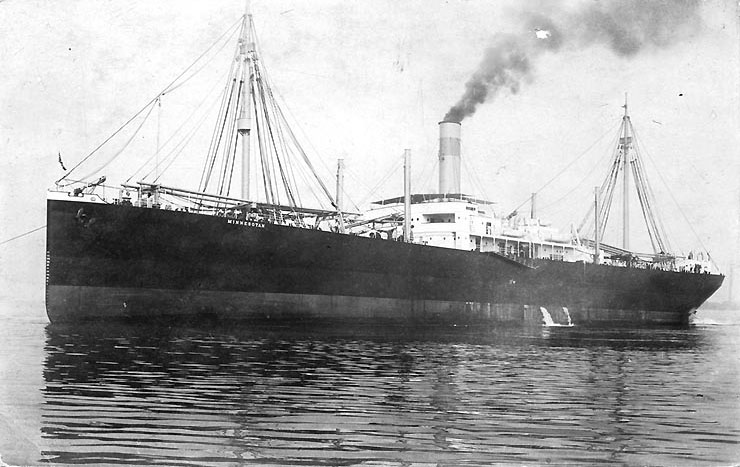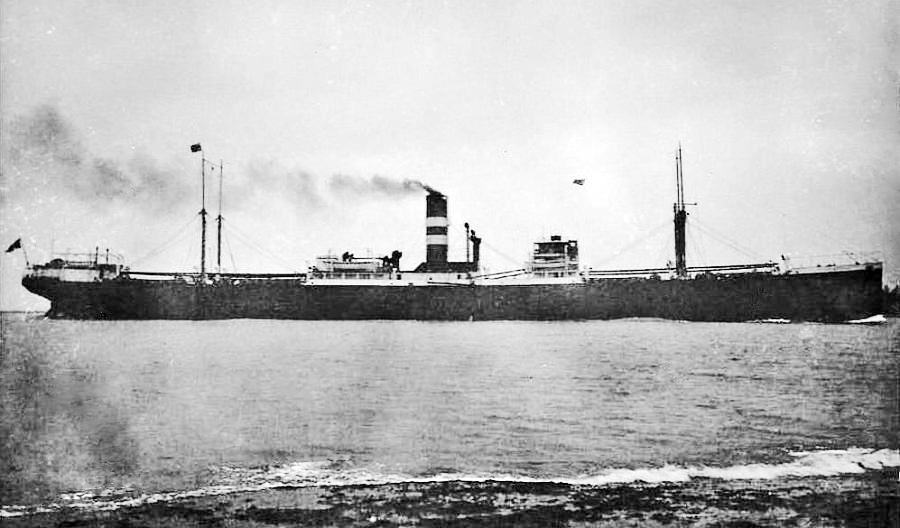Sept 21, 1914, 150 NM off Manzanillo Mexico.
HAPAG SS ALLEMANIA IN SAN DIEGO REPORTS HMS NEWCASTLE AND HIJMS IZUMO LEFT PORT 1530 HOURS AND STEAMED NORTH
SMS Niagara was painted in the livery of the Union-Castle Steamship line
SS Kildonen Castle, with her false funnel dismounted and stowed away, and her two legitimate funnels painted red with a black stripe on top. After receiving the report that
Newcastle and
Izumo had left the area, Von Schönberg placed
Niagara astride the Honolulu-Acapulco shipping lane for 7 days, but sighted no ships.
Sept 28, 1914, 150 NM west of Acapulco, Mexico.
Niagara moved south, and in the evening chased and stopped the 2000 ton French 4-masted steel barque
Wulfran Puget, carrying a load of copra from the Marquesa Islands to Acapulco. The ship had no wireless. The crew was taken aboard along with all useful provisions, and the
Puget was sunk with demolition charges. After 3 more days without spotting any ships,
Niagara headed south again, to interdict the western approach to the Panama Canal.
Oct 1, 1914. 200 NM south of Costa Rica.
Niagara saw many neutral ships approaching Panama, including a good number of American vessels, but none of belligerent powers. Von Schönberg declined to stop any of the neutral ships to check for contraband cargo, and kept a distance of at least 10 nautical miles from any ship.
Niagara stayed in the shipping lanes off Panama for a week without success, until she had run her oil tanks down to their lowest reserves. October 8 Von Schönberg arranged, by wireless using naval code, to meet
Desalba and
Bengrove at the remote Mexican island of Socorro.
While Niagara’s wireless operator was working his long-distance magic, he received a faint message in clear.
ALL SHIPS ALL SHIPS WARNING GERMAN CRUISER LEIPZIG REPORTED CAPTURING MERCHANT VESSELS IN GULF OF GUAYAQUIL STOP
“Aha!” said Von Schönberg.
Oct 11, 1914, Socorro Island, 370 NM west of Manzanillo, Mexico.
“This is the most desolate place I have ever seen,” said Von Schönberg, regarding the beige volcanic cone of Soccoro, baking under the tropical autumn sun. The island’s geographical features seemed limited to cliffs, arroyos, and bald patches in the scrub vegetation.
Desalba came alongside
Niagara in the lee of the barren island, rigged her hoses, and began pumping fuel oil. Transferring
Desalba’s entire load of 3000 tons of oil took 18 hours. Slowly the tanker rose higher and higher out of the sea. The crew had to ballast
Desalba to keep her from bobbing like a cork. The oil tanker, which perhaps ironically burned coal as fuel, was almost empty of coal as well, and so was very light. Von Schönberg had
Bengrove standing off at the horizon to act as a watch picket, but no vessels showed themselves.
A shore party sent to gather supplies returned with 4 dozen rather skinny feral sheep. “There is nothing else any sane person would want to eat on that rock, unless you were castaway and starving,” reported the petty officer who led the expedition. “And there is no water, either. Or shade. There are iguanas napping on every other rock, shy when they bother to wake up, and whole battalions of some kind of land crab. I can’t tell if the crabs are stupid, or friendly, or hungry, but they tried to mob us if we stood still for too long. The birds are small, and clueless, and somewhere between curious and indifferent to people. After we spent the day stumbling up and down cliffs hunting those sheep and looking for water, one of the species of birds following us around had learned how to say ‘Scheisse!’”
The following day, Von Schönberg reversed the positions of his auxiliaries, and had
Desalba outlying as a picket, while he had a work partly load 1000 tons of coal from
Bengrove into
Niagara’s coal bunkers. The work was exceptionally unpleasant in the hot sun. Another work party was climbing over the liner topside changing her appearance, again. A third funnel was erected evenly spaced behind the first two, and all three funnels were painted black such that the ship resembled the Anchor Line
SS Columbia. The painting crew was annoyed by the airborne dust of the coaling operation, but the disguise did not suffer.
Oct 14, Socorro Island, 370 NM west of Manzanillo, Mexico.
Bengrove cast off from
Niagara, having just less that 1000 tons of coal remaining in her holds. The three German ships moved offshore, back towards the coast of the Americas. Everything of value was brought over from
Desalba to
Niagara, the prize crew of 40 rejoined their compatriots aboard the big liner, and
Desalba slowly sank into the open Pacific until her bow lifted high in the air and she disappeared, stern first.
“We are at a juncture now,” said Von Schönberg, “where we could strike South West, at French Polynesia, or we could return to the approaches to the Panama Canal, or try and interdict the Nitrate trade from Chile.”
“I can’t think of what attacking French Polynesia would accomplish, Sir,” responded Lieutenant Reideger. “Other than scaring the living daylights out of the Frogs.”
“From an economic perspective,” said the former captain of Saxonia, “the Canal or the Nitrite trade is the clear winner.”
“Much of the effect we are having on Entente trade seems to be from scaring merchant ships into staying in port,” said Von Schönberg. “We could not damage the Panama Canal ourselves, but
Leipzig seems to have shut down all Entente trade through the Canal, just by showing up. Which creates a paradox. The more
Leipzig forces the belligerent merchant fleets to shelter in port, the less opportunity we have to take any as prizes. I say we go as far south as we can, and go hunting for the Chilean Nitrite trade.”
Oct 19, off the Gulf of Panama.
Niagara captured the 1800 ton French steel-hulled barque
Montmorency, carrying a cargo of sugar, coffee, and copra. From her crew Von Schönberg learned that Admiral Von Spee had bombarded Papeete on September 22, burned down 4 blocks of the downtown, sunk the gunboat Zélée, and had been frustrated from taking the coal stocks when the French garrison set them alight.
Montmorency’s crew was taken aboard, along with provisions and several hundred pounds of sugar. The French barque was sunk with demolition charges.
“Such a shame that cargo of coffee was not roasted,” lamented Von Schönberg.
In the following days, Niagara encountered a few neutral ships, but kept her distance.
Oct 23, off the Gulf of Guayaquil.
Niagara took the 4000 GRT steam freighter
Normanby, of the Pyman Brothers Steamship Company, London. Niagara’s wireless operator was forced to jam an attempted SOS, and the German ship had to fire a warning shot across
Normanby’s bow before she hove-to and received the boarding party. The British freighter was carrying a full cargo of saltpeter from the mines of Antofagasta.
Niagara took her crew on board, as well as a substantial amount of canned food.
Normanby was sunk with demolition charges, and her cargo burned fiercely before the flames were doused by the consuming ocean.
Oct 26, off Callao Peru.
Niagara caught the 6000 ton steam freighter
Crown of Seville, of the Crown Line, Glasgow, heading North for the Panama Canal.
Crown of Seville also had a full cargo of saltpeter. After taking her crew on board, Niagara had 185 French and British crew onboard as prisoners. Taking note that the British freighter had over 1100 tons of coal in her bunkers, Von Schönberg put a prize crew aboard, took her as an auxiliary, and sent her north to wait for him at the Galapagos Islands
Oct 27, off Iquique, Chile.
Niagara made wireless contact with
SMS Prinz Eitel Friedrich, a Norddeutcher Lloyd liner acting as an armed merchant cruiser, detached from Admiral Von Spee’s squadron.
Oct 31, San Felix Island, 500 NM west of Antofagasta, Chile.
Niagara met with
SMS Prinz Eitel Friedrich in the lee of San Felix Island, another small remote barren Pacific rock. Von Schönberg entertained the other liner’s commander, Korvettenkapitän Max Therichens, and some of his officers in
Niagara’s dining room.
“Alas, we have this floating palace,” said Therichens, “but the larders are mostly empty. We rarely serve any award-winning meals these days.”
“Yes, things are much the same with us,” confessed Von Schönberg. “I expect the great hotels of Europe are in a similar predicament, after 3 months of the war.”
“But this meal is exceptional,” replied Therichens, digging in. Von Schönberg noted that the chefs had done a wonderful job of making the Socorro Island mutton palatable.
The men exchanged news about their respective voyages, and Therichens’s eyes almost bugged out of his head when Von Schönberg reeled off the high points of the prizes he had sunk, and industrial targets
Nürnberg had attacked.
“I, on the other hand,” said Therichens, “have accomplished very little. We burned a French sailing ship 2 nights ago at Juan Fernandez Island, but even then it was Haun who captured her. I am considering going round the Horn, and trying my luck off Argentina and Brazil. The Entente shipping here is too spooked by Haun and Von Spee, and I suppose by you as well. They are mostly remaining in port.”
“I have noticed that as well,” agreed Von Schönberg. “Some freighters carrying nitrate were out this week, but I expect that will stop again. I will remain in this region, as long as I can. As I have discussed with my own officers, creating a panic among Entente shipping may be our greatest contribution to the war effort.” Over cigars, Von Schönberg learned that Kaiser Wilhelm’s Land and the Bismark Archipelago had fallen to the Kiwis and Australians. In fact all of the German Pacific colonies were occupied, with the possible exception of Tsingtao itself. Therichens apologized for not having current information on the siege of their former home port.
After learning that
Prinz Eitel Friedrich’s improvised magazines had been well stocked when the liner was being fitted out as an armed cruiser in Tsingtao, Von Schönberg asked for and received another 100 rounds of 10.5 cm High Explosive Shells for
Niagara.
That night, and all the next day,
Niagara and
Prinz Eitel Friedrich received faint but frequent wireless messages from the south, all using
Leipzig’s call sign, yet seeming to be a conversation between multiple vessels. A naval engagement was being prepared, then engaged in. The captains bid adieu and Niagara raised anchor and steamed north, while
Prinz Eitel Friedrich set a course to the south west. As
Niagara steamed north, the wireless operator eventually lost the signals.
SS Normanby

tighar.org
Screw Steamer NORMANBY built by William Gray & Co. Ltd. in 1911 for London & Northern S.S. Co. Ltd. (Pyman Brothers), London, Cargo 30/11/1929 wrecked on Gardner Island in the Phoenix Group on passage Melbourne for Honolulu in ballast.
www.teesbuiltships.co.uk
SS Crown of Seville
Screw Steamer CROWN OF SEVILLE built by Russell & Co in 1912 for Crown S.S. Co. Ltd. - Prentice, Service & Henderson, Glasgow, Cargo 13/11/1933 arrived at Troon for breaking by West of Scotland Shipbreaking Co. Ltd.<br />(other sources, at Dalmuir)
www.clydeships.co.uk

de.zxc.wiki

en.wikipedia.org





